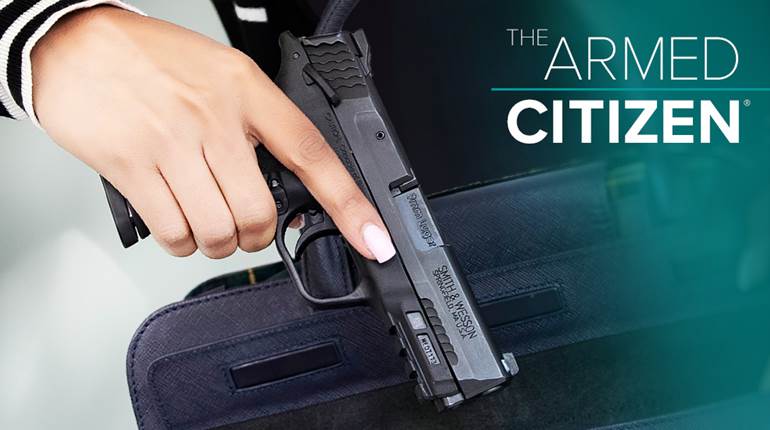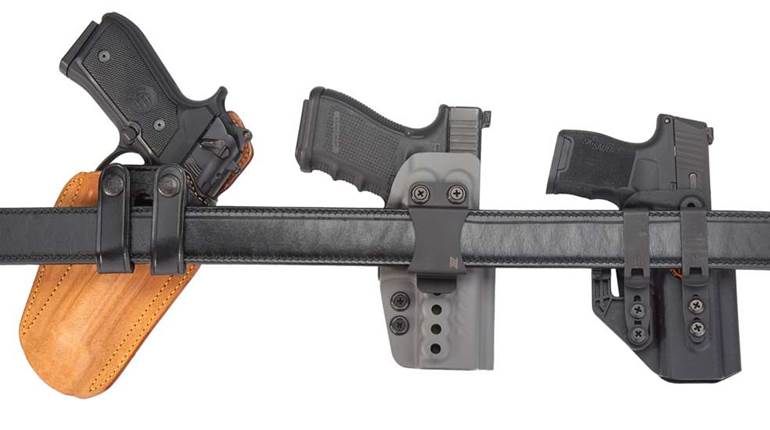
As reflected by increases in firearm sales and CWP applications, more Americans are expressing their 2nd Amendment right to bear arms. This also means more people are now trying to determine the best way to carry a concealed handgun.
There are multiple factors that influence carry method such as the handgun’s size and type, the person’s body shape and clothing worn, and the carrier’s imagination. However, there are a few accepted methods such as ankle, shoulder and strong side. Each of these has its advocates, but strong side (high on the waist near the strong hand) is the preferred method of many experts including American Rifleman Field Editor Wiley Clapp: “There are many ways to carry a gun, but the one that makes the most sense is high on the waist.”
Holster Choices
There are three types of commonly used strong-side holsters: inside-the-waistband (IWB), outside-the-waistband (OWB) and belly band. Each type provides varying degrees of concealment and accessibility.
IWB—Provides good cover via shirt or coat while keeping a handgun accessible, but requires an overly large waistband to allow fit. IWB works best with medium-sized, narrow handguns.
OWB—Keeps a handgun easily accessible, but requires a long cover garment to keep the holster from showing when bending or reaching. OWB allows carry of larger handguns.
Belly Band—Deepest cover for strong side, but handgun must be accessed by pulling up or ripping open the shirt. Belly band carry is best for small to medium polymer handguns as the gun is close to the body and susceptible to sweat.
The Good and the Bad
Regardless of the type of holster, strong-side carry has some definite advantages over other methods. First and foremost, the handgun is easily accessible. There is no reaching across or around the body as the hand is already near the gun. Another strong-side advantage is that it allows the use of the weak arm for close-quarters defense without interfering with the draw. Most importantly, the strong-side draw can be simplified to its most basic motions, which, with practice, creates a very smooth, fast draw. And practice is more readily available since many gun ranges limit how shooters can train from retention (holster), if allowed at all, to strong side for safety.
Of course, every carry method has its disadvantages. Strong-side carry has three distinct problems for shooters, the most significant of which is that it is difficult, if not impossible, to start with a hand on the gun. Lifting the cover garment for the draw almost always reveals the gun to potential threats. The other issues with strong-side carry are “printing” and car carry. Care must be taken to not print (when the cover garment tightens and shows the imprint of the gun) when bending over or reaching for an item. This is especially a problem in summer months when light, airy shirts are the norm. Car carry is difficult because with the gun on the strong side, the cover garment and seatbelt combine to make drawing the gun nearly impossible, but it can be conducted with forethought and practice.
Draw Strong
There are four basic motions to drawing a handgun from the strong side: the grip, the pull, the rock and the extend. Conducted properly, these motions lend themselves to the fast, smooth strong-side draw.
The Grip: Throw the elbow straight back, bring the hand back and grip the handgun firmly with the supporting fingers while keeping the trigger finger straight along the slide, outside of the holster.
The Pull: Pull the gun up and completely out of the holster keeping the trigger finger straight along the slide.
The Rock: Once the gun is clear of the holster, rock the barrel forward toward the target.
The Extend: Extend the gun into shooting position while bringing the support hand up and forward to the gun.
Draw Often
Drawing under stress requires muscle memory created through training and practice, especially if drawing from under a vest, shirt or other cover garment.
The best way to perfect the draw is slowly on a live-fire range with a partner watching for safety and mistakes. Start with smooth, deliberate motions and slowly build up speed. When practicing, keep in mind that slow is smooth and smooth is fast. Build on a smooth draw and speed will come.
If unable to conduct training on a range for lack of time, ammo or availability, you can practice in the privacy of the home. First, unload the firearm and remove all ammunition from the area. Then, practice drawing with slow, sure motions in front of a mirror while watching for mistakes. This will not provide the full experience, but it will improve your draw and provide the muscle memory to make the draw when the chips are down.
Regardless of the carry method, one of the most important factors of making a smooth, practiced draw is consistency in both the motion and the method. Acclaimed holster maker John Bianchi once doled out some excellent advice for concealed-carry advocates: “The same gun, in the same place, all the time, makes the reactive draw second nature.”






































